#IGB120
Text
GDevelop - Elevator Pitch for Racer Game
In the prototype of my Racer game, I'm crafting an engaging experience that blends simplicity with addictiveness, demanding fast thinking and decisive actions from players. Here's an Elevator Pitch outlining all the key aspects of my Racer Game prototype:
Name of Game:
Dash 'n Dodge
Description of Game:
Dash n' Dodge is an exciting top-down racing game where players take control of a speedy car on a mission to zoom ahead while avoiding obstacles. The goal? Race as far as you can while grabbing coins and speed boosters to push your limits and score big!
Genre of Game:
Survival/Racing
Target Audience:
Ages 7+
Mechanics of Game:
Boost: "Space" key
Movement: Arrow keys
Settings of the Game:
In the world of Dash n' Dodge, you're racing along the endless highway, dodging traffic and grabbing power-ups to speed ahead and rack up your score.
Elevator Pitch:
In Dash n' Dodge, you'll navigate an endless highway filled with oncoming traffic, a renowned racers' proving ground for speed demons. How far can you push your limits? How high can you climb the leaderboard? It's a test of skill as you aim for the ultimate glory!
Concept and Reference:
This game draws inspiration from popular mobile titles like "Subway Surfers" and "Temple Run," where players aim to outlast their previous best by running as far as they can on the course provided.
Subway Surfers
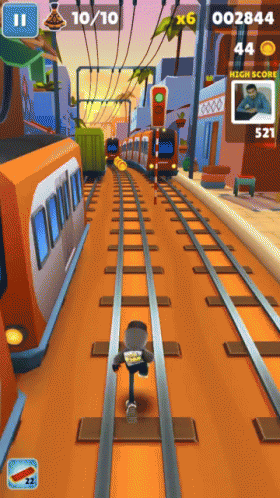
Source: https://www.pinterest.com.au/pin/797559415272934153/
Temple Run

Source: https://playtemplerun2online.wordpress.com/2014/08/04/feel-double-thrill-adventure-with-play-temple-run-2-online/
Conclusion:
To sum up, Dash n' Dodge takes inspiration from classics like 'Subway Surfers' and 'Temple Run,' adding its own unique twist. The aim is to evoke nostalgic memories of these beloved games while delivering an exciting experience with Dash n' Dodge.
6 notes
·
View notes
Text
The Way Home Post Mortem #13
Week 13 was a busy time for both the game and myself personally (due to unexpected sickness) - luckily things have now mostly wrapped up, after a scramble to finish playtests. Much of the week was a rush to implement feedback from about two participants each - a group ranging from friends to siblings who had never heard of the game before. Going into playtests we'd completed levels 2 and 3, both of which explored different concepts and themes - 2 was very puzzle focused, with the twist of needing to dodge a large enemy rat. 3 on the other hand, was almost entirely exposition and narrative focused, which felt like a good way to end out Bean's journey.
The results of playtesting were both surprising and expected. Playtesters quickly found issues and gave feedback that the team had never considered - things such as how it wasn't always obvious that objects could be used as platforms or clicked and otherwise interacted with. This hammered home the value of playtests being able to point out simple features and QOL improvements (such as automatic highlighting on interactables) that were simply skipped over because it was 'obvious' to us how things worked.

Overall the experience creating The Way Home was illuminating. I got to work in a group with other people sharing similar passions and collaboratively worked on a shared vision for a game. Being much less directed then previous endeavors in the class, I found it very enjoyable to go for a more unconventional spin on things learned in class - namely, the game's focus on the story of Beans finding his way home. While it didn't quite cover the depth of story I might have hoped for, I learned much about everything from Gdevelop, teamwork, playtests and just game development in general. Moving forward, I feel that I could do a much better job the next time around - always, in my opinion - an important feeling to be able to take away from any project.
Something I hadn't expected this semester was how much I've enjoyed writing this blog. While not always my best writing, expressing myself in a more personal first person perspective has been very different to anything else I've done at uni, expanding my horizons and comfort zone as a writer.
1 note
·
View note
Text
Assignment 3 Postmortem and GG
This will be my last post for Adventure Through IGB120. I will be reflecting on Assignment 3 as a whole. I am not proud what was made, I wish I could have done more for the project but I was horribly bedridden. I said when we started this project, my vision of the game was unclear and I believe it is still cloudy or worse. I don't know what the original design of the game was. Communication during the project was lacking, not many people kept saying what they changed for the game, ideas weren't fleshed out nor explained to the team. However this gave me an idea on how complicated that working with a team and how important communication is. I am also aware how important prototyping is and playtesting is. If I were to repeat this project I will be way more insisted that we meet in person and work on it together. This will give us much clear communication.
Anyway this was my Adventure Through IGB120 where I learned the importance of prototyping and Playtesting. Thank you for following me in my Adventure!
0 notes
Text
Interesting game mechanic discussion
As part of my studies in IGB120, I’ve been thinking a little bit more in depth than usual about games I’ve been playing. One thing I wanted to talk about is a super unique spin on the classic pokemon type chart from a game I played recently called Cassette Beasts.
Similar to pokemon, cassette beasts has monsters with types that interact with each other in particular ways. However, analysing their system of reward and punishment in the game is much more interesting than pokemon’s. Although pokemon’s classic “It’s super effective!” is nice to see, and the huge damage that can be output is a good reward, Cassette beasts has a popup in red text if a hit was effective, and in green if it wasn’t which helps communicate this difference using more effective means. Also, rather than only changing the damage, moves apply buffs and debuffs depending on if they were not very effective, or super effective. Debuffing your enemy can debilitate them severely, while buffing them by using a bad choice of move can make it near impossible to take them down. This leads to situations where picking a weak move to hit your own team with could flip the game in your favour, which I found to be an extremely interesting design choice to put a spin on a classic game mechanic.
8 notes
·
View notes
Text
Victory Galactic Devlog 1
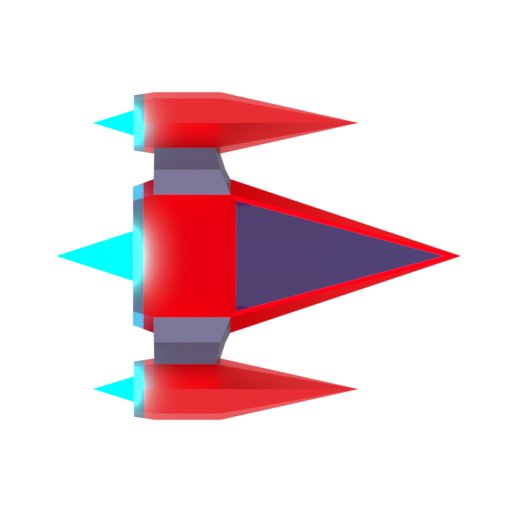
After grouping up it was decided that we decided that we would continue development of Victory Galactic for our final project in IGB120. We decided that we'd follow the original one page fairly closely. So we will be adding the proposed skins and speed running timers over the next few weeks. As Fullerton writes in Game Design Workshop Page 80 "In the real world resources are assets (i.e. natural resources, economic resources, human resources) that can be used to accomplish certain goals. In a game resources play much the same role". The speed running timers will be used to make time a valuable resource that is tied to a tangible reward and encourage the player into a fast paced playstyle.
The primary thing we decided we are going to try and get done by next week to all have the basic outline of a level which which we'll all develop individually in the beginning and then modify together into a cohesive whole later. Additionally Andrew proposed that he could implement a bouncy wall mechanic that would repel the player upon touching it I'm interested to see what he comes up and how it turns out.
References: Fullerton, T. (2018). Game Design Workshop : A Playcentric Approach to Creating Innovative Games. Boca Raton: CRC Press LLC.
3 notes
·
View notes
Text
An important thing to keep in mind when you are doing digital prototyping is to consider your reasons for each prototype that you make. - Fullerton (ch8, pg241)
Although there is an obvious main reason of why I am making this prototype being IGB120. However, I actually have very little experience with game design. So this rapid digital prototyping has served as a great learning experience. I have learned how to use GDevelop 5, make assets, use visual coding, and playtest. I have been able to develop a wide range of skills in a short amount of time. Although I still have a lot to learn, I can still feel my improvement with each prototype as I continue to grow as a developer.
Week 8 - Racer Development Progress 3
Playtesting
During the playtest I got some very eye opening feedback on how I can greatly improve this game. Although the playtester enjoyed the assets and theme, there were some major concerns that they wanted me to address. First of all, was that there was no gameplay loop. There is no way for the player to restart the game without reopening it which quickly became a problem when a playtester died very early on and the game played on without the player's ship. They enjoyed the cola powerup however, it didn't feel that impactful and wanted it to feel faster and not be so easy to get. Coins also seemed less impactful as they appeared in one straight line and there was no way for the player to miss collecting them. The game also broke some of the player' immersion as the background didn't move. This was a new problem that was created by changing a highway to an ocean as this is normally not required as the background looked like it was moving due to the moving trees on the sides. However, as I have moving clouds and birds, this no longer works and the Player ship feels static. Additionally, they also mentioned that the speed of certain objects felt wrong which also broke their immersion (e.g. the clouds moving too fast). Although there were a lot of things for my game to improve on, the playtester still had a fun experience with my game which let me know that I was still heading in the right direction.
Development update
Wow there is a lot to go through here. So for starters, I really needed to fix my loop code that I talked about in my first development post. Although it did work, it was very messy and as I wanted to create set patterns that would spawn, I needed to make it more optimised. Once that was done, I created a new spawning system that would either randomly spawn one random object in a random lane or a random set pattern. This created way more diversity and challenge, which my game was clearly lacking. Speeds of everything got adjusted to feel more immersive and the cola powerup now makes every go at 3 times the speed which feels way more impactful. The game also felt awkward at the start as there is a delay before anything spawns so I made my own workaround (as I couldn't find a way to set a timer to 2 seconds at the start of the game) to get rid of that initial delay. Creating the moving background wasn't easy but I managed to do it using duplicates of the background that move down and teleported back up to create the effect. This was one of my biggest challenges of making the game so far as I really had to think outside of the box to make it work. Finally, to finish the game off I made a title and game over screen. The game over screen displays the player's points for them to see.

References:
Fullerton, T. (2018). Game Design Workshop: A Playcentric Approach to Creating
Innovative Games. ProQuest Ebook. Retrieved
from: https://ebookcentral.proquest.com/lib/qut/reader.action?docID=5477698
2 notes
·
View notes
Text
About Me
Hello! My name is Thomas I also go by Random online! I am currently studying a bachelors of Games and Interactive Environments at QUT. My main area of interest in game development is creating art for video games, and as a long-time digital artist particularly I enjoy character design. My current goals during my study is to become a video game artist through my degree and as such I am hoping to take the animation major during my next semester of study.
My goals throughout this unit of study in IGB120 are to learn and understand the process of playtesting as a game developer and how to successfully create prototype games and iterate on them. This includes:
The ability to create elevator pitches that allow for creative and interesting to arise during development, whilst setting foundations for the prototype.
Being able to pose questions during the playtesting phase that incite playtesters to give valuable feedback related to questions I have related to the game design elements of my game/s.
Taking constructive criticism and iterating on my prototype based on any concerns or complaints about the design of the game.
2 notes
·
View notes
Text
Platformer 1: Elevator Pitch
Game Title: The Guard of Joseon.
With his country under attack by a powerful unknown force, a young Korean solider must battle and defeat the attackers, swiftly making it to the palace where his King resides, protecting him from the fiercest of the enemy line. Will he make it in time, or will his kingdom be overthrown?
The Guard of Joseon is a 2D PvE platformer game set in the last dynastic kingdom of Korea, the Joseon Dynasty, which is under brutal attack. The player is in control of Jeong-gyu, a Korean soldier well established within the army ranks, who must fend off the attackers and most importantly, save his king! This game is targeted towards a young adult audience who enjoy platformer combat, and more specifically those who have an appreciation for history and the hardships faced in war times.
The player will be motivated to race against the clock to succeed, picking up upgrades, boosters, and extra rewards along the way. The road to the king’s palace will not be direct, rather there will be multiple routes the player can take, facing off against different enemies along each path.
The controls of the game entail the arrow keys for movement (left is left, right is right), space bar to jump, and mouse-controlled aim of arrows with left-click shoot.
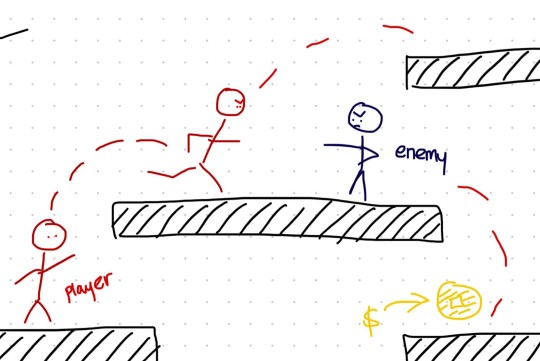
I have included inspiration photos below:



Image 1 Source: Dana Clement, 'Gyeongbokgung Palace Museum' 08/02/24.
Image 2 Source: Dana Clement, 'Royal Guard' 08/02/24
Image 3 Source: Dana Clement, 'Goguryeo Cavalry' 25/02/24.
This is my first prototype for IGB120, in which we were tasked to create a platformer game in GDevelop. Although the platformer genre has a large variety, given the engine and accessible assets, I went for a more traditional 2D platformer that explores different terrains and environments in a linear format. I am not going for a super complex game given the timeframe for this project and being unfamiliar with GDevelop. I believe my goals for this game are achievable, as I want to create a simple yet fun and compelling game that explores typical platformer elements with my own ideas.
2 notes
·
View notes
Text
Platformer Elevator Pitch (Pt. 1)
My first project, as part of IGB120, will be a platformer made on the Gdevelop 5 engine; however, I need to develop the game throughout the concept stage and create an elevator pitch before the game can begin to be developed.
This week chapters 1 and 2 of "Game Design Workshop" clearly articulated the process to developing a playcentric game. Tracy Fullerton explained the importance of creating player experience objectives with solid gameplay interactions in mind, and how the core gameplay mechanics need to be well thought-out before development can even begin.
Fullerton illuminated that the most important aspect of a game is fun and engaging gameplay; if the player isn't enjoying the gameplay, they will discontinue playing. Fullerton then established that to ensure the gameplay keeps a player engaged a play centric design model needs to be implemented where the player experience is put at the heart of the design process. In order for a game to follow a playcentric design it is critical that prototypes are developed as soon as the core mechanics and player experience goals are devised to get player feedback, in the form of playtesters, as early in the design process as possible.
For my platformer I want the core mechanics to include movement, such as jumping, running, and double jumping; and the player experience goals to include encounters with enemies, physics puzzles, and hidden collectables.
References
Fullerton, T. (2018). Game Design Workshop: A Playcentric Approach to Creating
Innovative Games. ProQuest Ebook. Retrieved
from: https://ebookcentral.proquest.com/lib/qut/reader.action?docID=5477698
2 notes
·
View notes
Text
Assignment 3 - Postmortem
As we reach the end of our development cycle, it's time to reflect on the journey of creating our game. This post-mortem highlights the key aspects of our development process, the challenges we faced, and the successes we achieved.
Concept and Vision
Our game was envisioned as an engaging platformer with a focus on fluid movement mechanics and a captivating story. We aimed to blend challenging gameplay with a rich narrative, providing players with an immersive experience.

Development Highlights
Initial Prototyping:
Core Mechanics: We started with the basics – running, jumping, and dashing. Early prototypes focused on perfecting these mechanics to ensure they felt responsive and satisfying.
Visual Design: Initial art assets were created to establish the game’s aesthetic. We focused on a vibrant and inviting visual style to attract players and create a memorable experience.
Playtesting and Feedback:
User Feedback: Conducting multiple rounds of playtesting was crucial. We gathered detailed feedback on controls, level design, and overall gameplay experience. This feedback was instrumental in shaping the final product.
Iterative Improvements: Based on playtester feedback, we made several iterations. Key changes included adjusting control mechanics, enhancing obstacle visibility, and revising the lives system to balance difficulty.
Final Touches:
Narrative Integration: We refined the storytelling aspects, embedding the narrative more seamlessly into gameplay. This helped create a cohesive experience that kept players engaged.
UI and Visual Enhancements: Final adjustments to the UI and visual elements ensured clarity and improved player experience. This included adding visual indicators for abilities and interactive objects.
Challenges Faced
Balancing Difficulty: One of the main challenges was finding the right balance between challenging gameplay and accessibility. Ensuring that the game was difficult enough to be engaging, but not frustrating, required multiple iterations.
Technical Hurdles: Implementing smooth and responsive controls while avoiding bugs was a significant technical challenge. Issues with dash mechanics and collision detection were particularly tricky to resolve.
Successes and Achievements
Player Engagement: The positive feedback from playtesters on the game’s art style and core mechanics was a huge success. Players enjoyed the visual design and found the movement mechanics satisfying.
Community Involvement: Involving the community through playtesting and feedback sessions was invaluable. It not only helped improve the game but also built a supportive community around our project.
What’s Next?
While this marks the end of this development cycle, it’s just the beginning of our journey. We plan to continue refining the game based on ongoing feedback and are excited about future updates and potential expansions.
Thank you to everyone who supported us along the way – from our dedicated playtesters to our talented development team. Your contributions have been essential in bringing this game to life.
0 notes
Text
Assignment 3 Development #11
Week 11 came with the first developing prototype of our group project "The Way Home" - to start we had a title screen and level select.

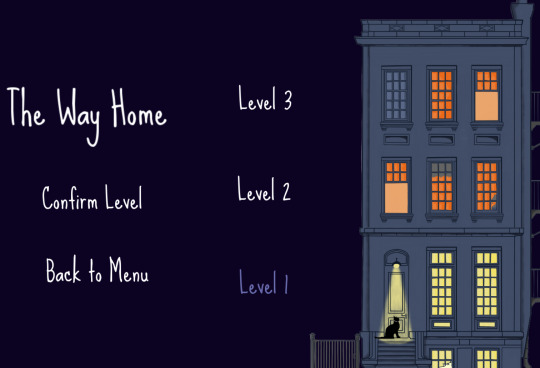
Designing this was a unique test, as I hadn't previously done any prior work with menus. While not complex to delve into, I ran into an unexpected issue with the font - we had been wanting to use the Sue Ellen Francisco font for it's homey style, but the typical text of Gdevelop couldn't properly display it. The font was too tall for Gdevelop's display boxes, leading to the use of a free converter to turn the font into variously colored BitMaps for use in the game. Once this was settled, the main meat of the 1st level was created. We had decided on Beans - the new name of our feline protagonist - needing to explore the side of the building to find a way inside.
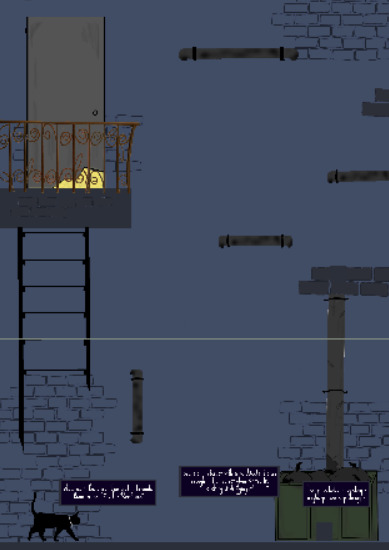
To do this, we used a couple of gently guided puzzles (a movable bin and a climbable drain pipe) to introduce the player to the game and it's fairly standard platformer movement.
Making this process, one of the more tedious parts was having to construct dialogue bubbles and text, which reduced and decreased in opacity depending on play distance. This proved time consuming given Gdevelop's lack of functions, but was ultimately simple. Moving forward into the next week, the group plans to finish constructing level 2 (with our first and only enemy, no less!). We intended this one to be a more difficult level with less handholding and a more substantial challenge for players.
0 notes
Text
Assignment 3 Update and Playtesting
So its been awhile since my last post, I have been hit with Bacterial Pneumonia so I have been almost completely bedridden this pass week including now.
Anyway the project is progessing... slowly? To be honest, I think its quite the mess, and like I said in my last post I just don't see the same vision as everyone else does, and it doesn't really help that the person who propose the game isn't active on Discord. Anyway so I have been doing bug fixes... mostly. Somehow the whole resolution for the game was messed up. And I have just been trying to clean up the code and small bugs that I encountered.
This was also my week to do some playtesting. Last week we tested two people and changed the game according to that like the Playtesting Protocol says. I am going to two of my friends to playtest it. One plays on a laptop the other plays on console so we got a wide audience. I will follow the playtesting protocol just like how I written it up.
0 notes
Text
About me.
Hi! I’m Violet, and I’m using this blog to chronicle my work/learning experience throughout the Bachelor of Games and Interactive Environments at QUT. Specifically, it’s a requirement for IGB120, but I hope I’ll be able to showcase work from other courses as well!
I’ve played a really wide variety of games (If you can name a genre, I’ve probably played it at least once! (except for RTS games, not a fan of those...)), so naturally my interests in the gamedev space are varied as well. I want to create as many games as I can, with as many different and intriguing aesthetics, stories, and designs as possible. If I had to narrow it down, I am particularly interested in level design, and creating fluid and fun movement options.
Within IGB120, I want to nail the basics of design and internalize concepts I'll need going forward in my career as a designer, and I also want to make some prototypes that show off my ideas and creativity, and are hopefully fun as well!
Look forward to more posts about a platformer prototype I’ve been working on soon!
2 notes
·
View notes
Text
Platformer Game - Elevator Pitch
as part of IGB120, one of our tasks is to create and platformer game prototype!
What makes a good platformer game?
Gameplay Mechanics
Gameplay mechanics in good platformer games need to be fun and fluid. Uniqueness of the mechanics also play a factor in creating a memorable and successful game.
(Yeung, 2021), (Martin, 2022)
Engaging Level Design
The Medium describes Level Design as a pivotal aspect of game development, level design is what makes a game.
creating an engaging level design, is creating the feeling of progress.
Engaging level designs allow the players to go through the game, immersed and more likely to re-play the level or game over and over, and find more story secrets or to find new and more creative ways to pass the level.
Balance is also a key aspect of a good level design. you don't want the enemies to be too strong or too weak, or the puzzles too easy or impossible.
(Teres, 2023)
Obstacles and Challenges
Obstacles and challenges are part of every game in existence. these challenges can include a rhythmic or patterned behavior in boss fights,
spikes or sharp objects that lead to a player losing hearts before game over, moving obstacles that have the player wait for the perfect moment to jump on, jump off, or move quickly to avoid the platform dissolving,
as well as blockades and barriers that force the player to think more creatively and use different game mechanics to get through the level.
(Games, 2023)
______________________________________________________________________________________________________________________
So, What is My Platformer?
The Curious Case of Hotel Hollow is a 2d pixel-art platformer that has the player use interactive characters and platform mechanics to collect clues and solve the case of a murder. The twist is that the murderer is in kahoots with the spirits of those who previously passed in the hotel, and these spirits will do whatever they can to stop the player from solving the case.
The game is rated PG (7+) as it contains mature themes such as abstract violence, implications of murder, and some course language.
______________________________________________________________________________________________________________________
What is my gameplay?
My game will focus on the standard pixel-art platformers that people know and love. It will feature the ability to swat away enemies and use 2D blocks to platform their way through each level and collect items that will help solve the puzzles.
Why will it be compelling?
Players will need to navigate through the levels, collecting clues to solve a puzzle while also combatting enemies that are trying to stop the player from solving the puzzle.
the game will include interactable characters that help tell the story and provide extra clues to help solve the problem while also steering the players in directions away from the solution.
Who is the target audience?
ages 7+
What is the players role?
The player is a small detective that is visiting the hotel for a trip - they must go through each floor of the hotel to solve the case.
How will you motivate the player? How will you reward them?
Dialogue changes.
Sound and visual effects
Collecting clues
Item upgrades
What genre is the game?
puzzle / murder mystery / platformer.
What is the setting of the game?
The game is set in an old hotel that is known to be haunted. The player must fend off the ghosts that are trying to stop them from solving the case while finding clues.
______________________________________________________________________________________________________________________
Concept Art: The Inspirations

Inspiration for the hotel Lobby - this will be stylised into a more historical aesthetic such as curved windows, curtains and a candlelight glow.
Credit:
Leveldesign for the Pixel Story Game "Lacuna".
The first game of the new Game Studio "Digitales".
Janina Heese
Freelance GameArtist & Illustrator
found on: Janina Heese - Pixel Art | Hotel | Lobby (artstation.com)

Snapshot of a character sprite commission - this is the size of the sprites for both player character and NPC characters while also having some smooth animations for running and jumping.
Credit: (Kich, 2016)
Major Pixel Art Commission - Orange Season
Lucas Kich
Freelance GameArtist & Illustrator
found on: Major Pixel Art Commission - Orange Season :: Behance
____________________________________________________________________________________________________________________________
Sources used in this post include:
Yeung, O. (2021, November 4). All about great platformer games. 8BitCADE. https://8bitcade.com/blogs/blog/all-about-great-platformer-games#:~:text=Jumping%20mechanics%2C%20fighting%20moves%2C%20and,to%20reach%20their%20end%20goal.
Martin, G. (2022, March 7). The most unique gameplay mechanics in platforming games. TheGamer. https://www.thegamer.com/unique-platforming-game-mechanics/
Teres, G. (2023, January 12). Designing engaging levels: The key principles of Level Design. Medium. https://medium.com/@unidaystudio/designing-engaging-levels-the-key-principles-of-level-design-2ecb365a445a
Games, R. (2023, December 25). Platformer level design tips. Medium. https://medium.com/@RetroStyle_Games/platformer-level-design-tips-03068c087659#:~:text=Spikes%20and%20sharp%20objects%20are,and%202D%20platformer%20level%20design.
Janina Heese - pixel art | hotel | lobby. (n.d.). https://janinaheese.artstation.com/projects/2xaZWY
Kich, L. (2016). Major Pixel Art Commission - Orange season. Behance. https://www.behance.net/gallery/130852409/Major-Pixel-Art-Commission-Orange-Season
3 notes
·
View notes
Text
Introduction
Hello! My name's Mila Boyd and this is the beginning of my IGB120 blog. I am a GaIE degree student majoring in software technology and I am very excited to start learning all the ins and outs of game development.
I've participated in game jams in the past with friends as an artist, but have never gotten into the programming and design parts properly, so am excited to develop my skills in these areas as well as getting to meet and work with other people with similar interests to me!!

2 notes
·
View notes
Text
Welcome to IGB120
Welcome to my IGB120 Game Development journal! This blog will serve as a weekly update on my journey through the game design class, sharing insights, progress, and challenges I encounter along the way.
Hello, and welcome to my game development journal! My name is Marcus Frohlich, and I’m excited to share my journey through the IGB120 Game Development course with you. Each week, I will document different aspects of my development process, showcasing my work and learning experiences.
1 note
·
View note